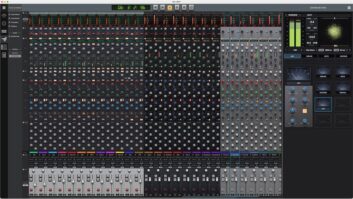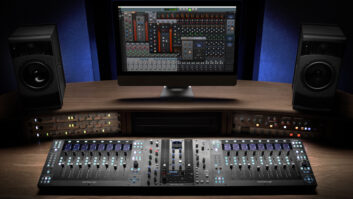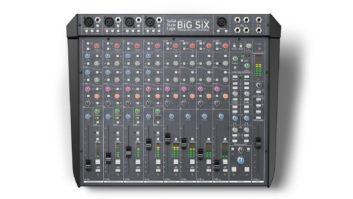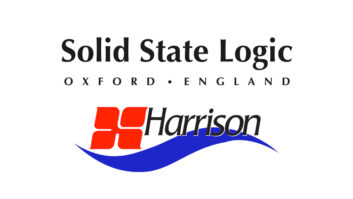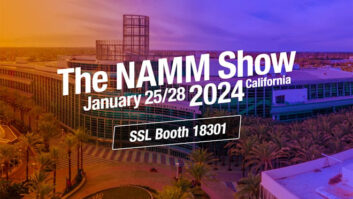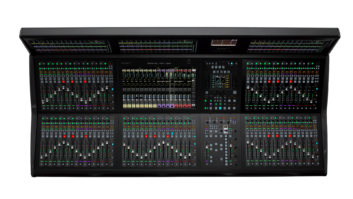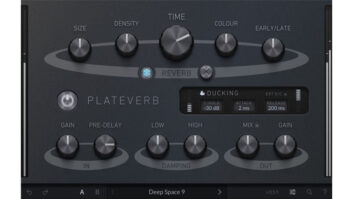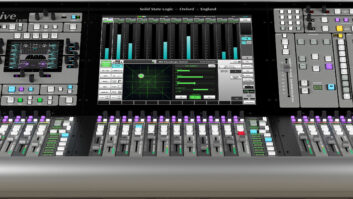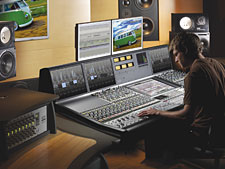
Two years ago, Solid State Logic unveiled the C100 and C200 — two scalable digital consoles designed for broadcast and production applications. At AES, SSL will show the next entry in its successful C Series, a fully configurable, multi-operator board for film mixing and large-scale video post installations.
The C300 mixer takes some of the series’ familiar concepts — such as up to 512 inputs from a single Centuri centralized DSP and I/O core — and adds to the package with HUI emulation control of up to four DAWs simultaneously, 64 PEC/Direct switches, 8-channel monitor insert points supporting 7.1 mixing, 128×8 monitor matrix, support of up to four sets of monitor speakers and a 32×16 re-record matrix. The latter is especially useful for creating simultaneous mixes — say, in creating a final and an M&E mix (for later foreign dubs) in the same pass.
“The C300 definitely has some elements of the 100 and 200 in it, but it wasn’t a case of 100 + 200 = 300,” explains SSL product manager Andrew Clark. “We wanted the 300 to take some significant steps forward, and its DSP engine is one part of that because its presentation of resources is quite different to match it to post-production work methods, although the hardware is the same and its level of integration with workstations is a generation ahead of our other consoles.”
The C300 can handle mid-level post or be scaled up to a full-blown, 128-fader, three-operator system with 512 inputs to mix, so it can also handle large film mixes. In that configuration, each operator’s ability to have access to different workstations — for music, dialog and effects — offers a very powerful productivity tool.
Conversely, the console could also be small. “The control surface and DSP are completely independent, so you could have a 16-fader surface handling 500 inputs and 80 output buses,” Clark adds. “One of the advantages of the C Series is that users can scale a system to their initial needs and later expand in terms of the physical control surface and the resources available to the user.”
In developing the C300, SSL spent a lot of time talking to customers and listening to their needs; these days, one major factor driving the market is efficiency. “Specifically, the final mix time is the most pressured with the least spare time available,” says Clark. “One of the key needs of a post console is its ability to be quickly reconfigured, so when the session changes, the operators don’t have to perform a large-scale reconfiguration to get to where they need to be.”
One aspect shared among the C Series consoles is the Centuri core, a central unit that accepts up to eight DSP cards and is linked to the control surface. However, the C300 presents Centuri resources as an assignable pool of processing resources, such as filters, EQ, dynamics, insert points and channel delay — all with automatic latency compensation. One nice touch is Dynamic Resource Allocation™, which optimizes DSP usage — instantly replacing a 2-band EQ with a 4-band whenever more than two bands are switched into a circuit. The other aspect of the Centuri core is I/O, with slots for eight cards in a choice of AES, MADI, analog line and mic preamp connections.
The Master Channel is a hardware panel offering “one-knob-per-function” access to controls such as EQ, dynamics and aux flow parameters, with a familiar look and feel that’s particularly important to first-time users. If desired, an additional panel can be fitted into any channel bay, providing multiple access points. One option is a motorized X/Y joystick controller that can be mapped to any two processing parameters.
The overall impression of the C300 is that it was built for speed: High-resolution TFT screens above each fader set display routing, processing and metering, which are combined with a master touchscreen for monitoring and machine control of the built-in synchronizer with four serial control ports. Its TimeFreeze™ automation enables slow-motion operation with no need for external time code, and channels can be easily linked to create stems up to 7.1.
“An important aspect is the C300’s integration into the production environment,” notes Clark. “Digital workstations are a major part of every stage in the post-production process. At the mixing stage, DAWs may simply act as playback decks, but often, there’s a lot of hybrid interaction between the workstation and the console. The C300 gives users the opportunity to have everything in one place, with the console surface acting as a controller of the workstation.
“For some projects, mixing completely inside the box may be acceptable; the console surface provides the interface to the workstation’s DSP and mixing. Other times, you’re mostly mixing stems, with premixes coming to the console from the workstation. On some stems, you may need to get inside the component elements within a stem; here, workstation control allows these to be manipulated and remixed before they are mixed and fed as stems into the console. This also offers the advantage of rewriting the automation information inside the workstation — a powerful way of integrating the workstation with the console.”
The C300 makes its AES debut this month, but this is no unveiling of a “dream car” or prototype. The C300 is in production, with the first installs slated for December.
For more information about the C300, visit www.solid-state-logic.com or AES booth #801.
